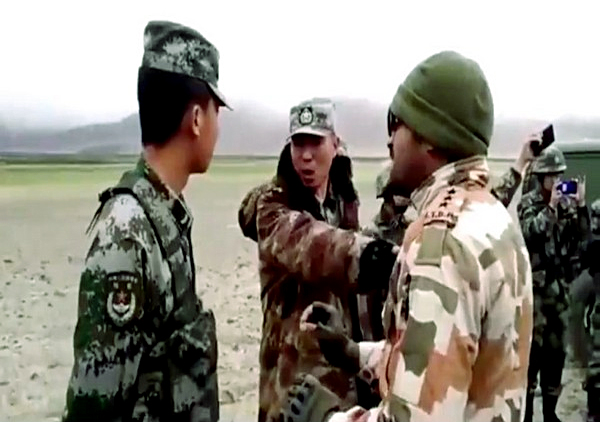ITBP is responsible for guarding India-China border. But Army has to underwrite the entire effort when things turn nasty.
China’s border belligerence has made news around the world. It has land border disputes with India, Bhutan, Nepal (yes, Nepal too). On the eastern front, it has disputes with Taiwan, Vietnam, Philippines, Malaysia and Brunei over the Spratly and Paracel Islands and separately with Japan in Senkaku Islands.
The India-China disputed part of the border called Line of Actual Control (LAC) is spread over 3,500 km. For several decades, China concentrated on its economic development, while it continued modernising and restructuring of its Armed Forces to achieve its stated aim of replacing the United States as the sole superpower by the middle of the century. In line with that goal, China has become more belligerent on all borders over the last decade or more. While India-China face-offs have been disentangled in the past due to a series of military and diplomatic mechanisms which were in place, this is the first time since 1979 that China has got a bloody nose, however tactical in nature and scale. The last such time was when China attacked Vietnam, and Vietnam’s Peoples’ Army gave the Chinese PLA a bloody nose, despite one hand tied behind their back because of their army’s deployment in Cambodia to subdue the Khmer Rouge.
Indian soldiers not only stopped the transgression in Galwan, but also matched the Chinese soldiers in violence and operated in the sub-optimal zone of unarmed combat, which seems to be an anachronism in modern times. For all their denials, a quiet acceptance of Chinese casualties has started trickling in. It will never be an official release. For all its bluster and even some build-up in rear areas, the Chinese have agreed to disengage its troops in contact. Why?
China has opened too many fronts at the same time—South China Sea and Japan in the maritime zone in the east; it also has ongoing issues in Hong Kong and Xinjiang; and if only to keep a count, Tibet and Outer Mongolia could also resurface. In view of these disputes, while fighting the corona pandemic at home and a trade war with the US, can China afford to have even a limited war with India? China will lose upwards of $70 billion worth of trade from India; because India will be forced to snap trade in case shots are fired across the LAC. Can China take on all of this at the same time?
If not, this is the time for us to take advantage and streamline our responses. There are some measures that we must take in concert with other countries having similar interests, and there are some measures that we must take within our country. We must get our geopolitical balancing right, create strategic linkages with countries and groupings where there is convergence of interest. Our recent logistics agreements with Australia are a good step in that direction on the lines of similar arrangements with the US and other countries. We must also employ all diplomatic and economic leverages that we can, in concert with other nations, given the world sentiment, post the outbreak of the corona crisis. Towards this thought, much has been heard and said in the national discourse over the last one month.
However, there also is an urgent need to look inwards at our responses on matters of national security. Increasingly, we are going to be dealing with sub-optimal responses from China and Pakistan across the LAC and LoC, respectively. These also include information warfare. We would do well to redesign our security mechanisms to meet these challenges.
Let us take a hard look at our border guarding and be ruthless about it. Border guarding at India-China borders is a responsibility divided. As per the “one border one force” dynamics, Indo-Tibetan Border Police (ITBP) is responsible for guarding the India-China border. Is the arrangement adequate? The Army has to underwrite the entire effort when things turn nasty. The Army has been asking for operational control over the ITBP. To make matters worse, both are under different ministries. Navy and Coast Guard are under the same ministry, that is Ministry of Defence, and yet have similar command and control coordination issues. A better parallel can be drawn with the successful model at the LoC, where BSF is placed under the operational control of the Army.
Lines of authority and accountability should be clearly defined in a manner that security is optimised. Accountability for lapses has to be unforgiving, which can only happen when there is no obfuscation. Being effective on an unresolved border is the first important step that needs to be taken. Let the two ministries and two forces—Army and ITBP put their heads together to decide a better model of integrated operations. There is also the issue of intelligence gathering and information warfare, which involves intelligence agencies and more.
The next important step that enhances our operational potential is the road communication infrastructure in the border areas, as it assists military mobilisation. All other enablers of mobilisation must be enhanced, whether it is all-terrain vehicles, helicopters or more. Employing sons of the soil in these border areas should be increased. Ladakh Scouts was upgraded to a full-fledged regiment of Indian Army after the Kargil War. Even the ITBP could increase their share of recruitment from these areas. They can also buttress tactical level intelligence, a subject that needs serious consideration.
China’s assertiveness under its present leadership and context is here to stay. Therefore, we can expect more of the same, also for the strategic reasons that I discussed in this column a fortnight ago. It is time we prepare for this challenge in right earnest, starting from the tactics on the ground zero, the LAC.
Lt General Satish Dua is a former Corps Commander in Kashmir, who retired as Chief of Integrated Defence Staff. Views expressed are personal.

